2019 Mazda 3 vs. Honda Civic vs. Toyota Corolla vs. Volkswagen Golf vs. Hyundai Elantra GT
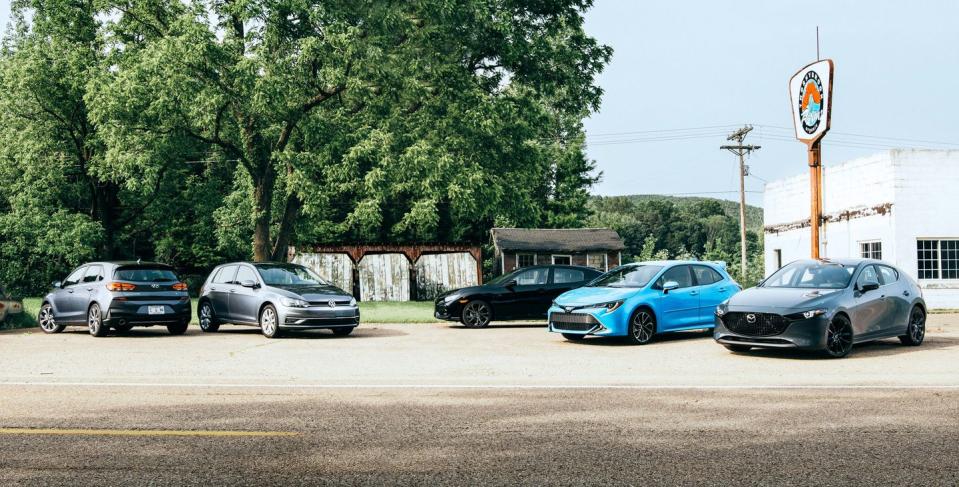
It's hard out there for a driving enthusiast on a budget. Cars in general are better engineered, more powerful, and better performing than ever, but for people with $25,000 to spend on a new car, the choices are generally between an econobox and an econobox in mini-crossover form. But there is a sliver of the market, perhaps preserved specifically to facilitate magazine spreads like this one, that can serve the frugal car fiend: hatchbacks with manual transmissions. Enthusiast-oriented hatchbacks are a healthy genre of the U.S. car market, despite their relatively narrow appeal. Even as the demand for SUVs encourages automakers to tack body cladding on to increasingly improbable vehicles, sporty hatches are hanging on. Whether it's because carmakers recognize the innate goodness of these spirited little boxes or because continuing to build them in small numbers acts as virtue signaling that draws enthusiasts to a brand's other offerings, we're enjoying the ride while it lasts.
There's an undeniable logic to buying one of these row-your-own hatches if you've only got the cash for one car. Hatchbacks are compact, so they're relatively efficient and feel light and lithe on the road. They typically have more cargo space than sedans do, so they're practical for drivers who demand flexibility from their cars. And these not-quite-hot hatches are often tied to performance variants of the same cars, so you can have a taste of what you can't quite afford. Despite the questionable business sense of even offering a car in this category (Americans aren't known for our fondness of hatchbacks or manual transmissions), there are a number of new or recently redesigned models to choose from.
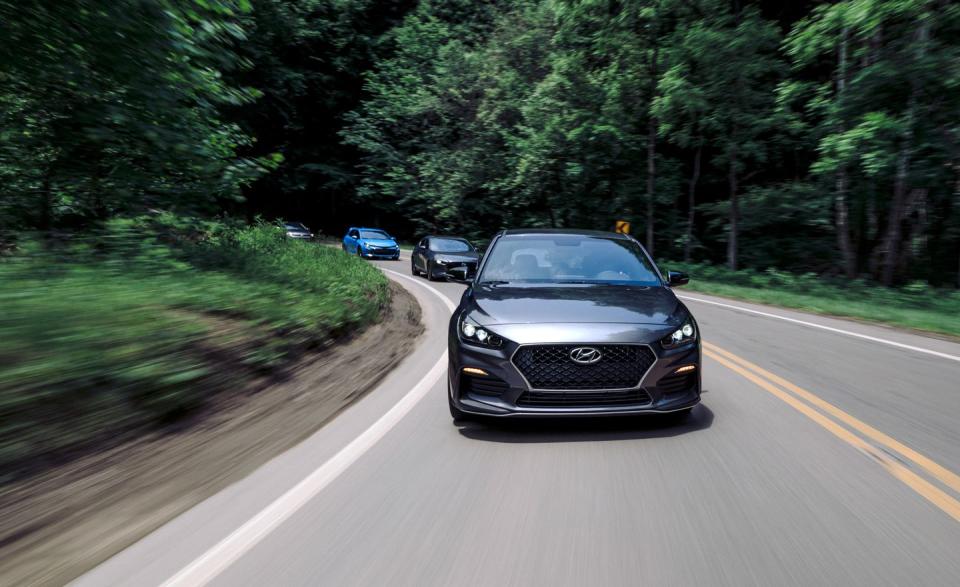
The Honda Civic Sport hatchback isn't exactly fresh, having made its debut in 2017, but it earned its spot here as the winner of an April 2017 comparison test. The Sport hatch comes standard with a 180-hp turbocharged 1.5-liter inline-four—that's six more horses than you get in the base Civic—and a manual transmission. A CVT is available for $800, and it's possible to spend a few grand extra on a fancy set of wheels or a performance appearance package. We like the Civic just as it is, so our test car cost a completely reasonable $23,170.
The Hyundai Elantra GT N-Line is a newer entrant in this segment. Europhiles will recognize the GT as a rebadged Hyundai i30. It was new to these shores in 2018, and the N-Line trim, intended to evoke the hard-edged sportiness of Hyundai's Veloster N, is new for 2019. The GT starts at $21,370, but to get the N-Line's 201-hp turbo 1.6-liter four, retuned steering and suspension, and manual transmission, you'll have to pay at least $24,220.
The Mazda 3 has been redesigned for 2019, and it's taken a hard turn toward luxury. The hatchback starts at $24,520, but the pricey Premium trim is now the only way to get a manual transmission. That package adds leather seats, LED lights, a head-up display, floor mats, and navigation. With a few dealer-installed extras, this example crossed the block at $30,060. All Mazda 3s come with a 186-hp 2.5-liter inline-four under the hood.
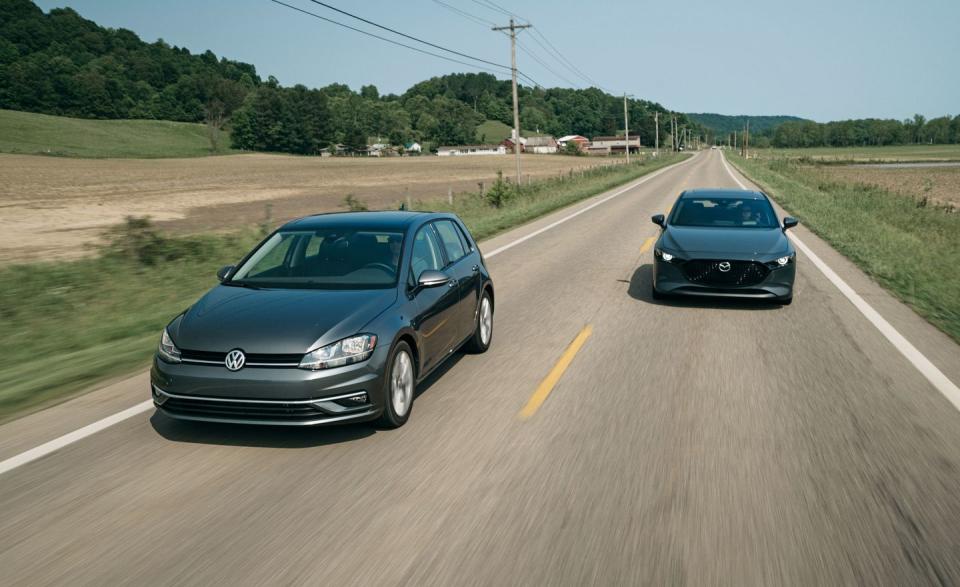
Toyota's Corolla hatchback was also redesigned for 2019 (ahead of the ubiquitous sedan's 2020 overhaul). The hatchback's new look is angular and sporty, and the 168-hp 2.0-liter inline-four is significantly more powerful than the outgoing 1.8-liter engine, which topped out at 137 horsepower. The Corolla hatch starts at $21,070, but we would have had to pay $25,578 for this particular XSE-trim model, the big-ticket options on which were the adaptive headlights and rear spoiler.
Rounding out the pack is the aging Volkswagen Golf, due to be replaced by the eighth-generation model in 2020 but still included here because of its place on the 10Best list and its strong performance in past comparison tests. Starting at $22,740, the Golf S comes standard with a six-speed manual and a 147-hp turbocharged 1.4-liter inline-four. That engine, new this year, is quite a bit less powerful than the 170-hp 1.8-liter it replaced—not usually a good sign. Our Golf, an SE model fitted with a $1295 driver-assistance package, totaled $26,335.
5th Place:
Toyota Corolla
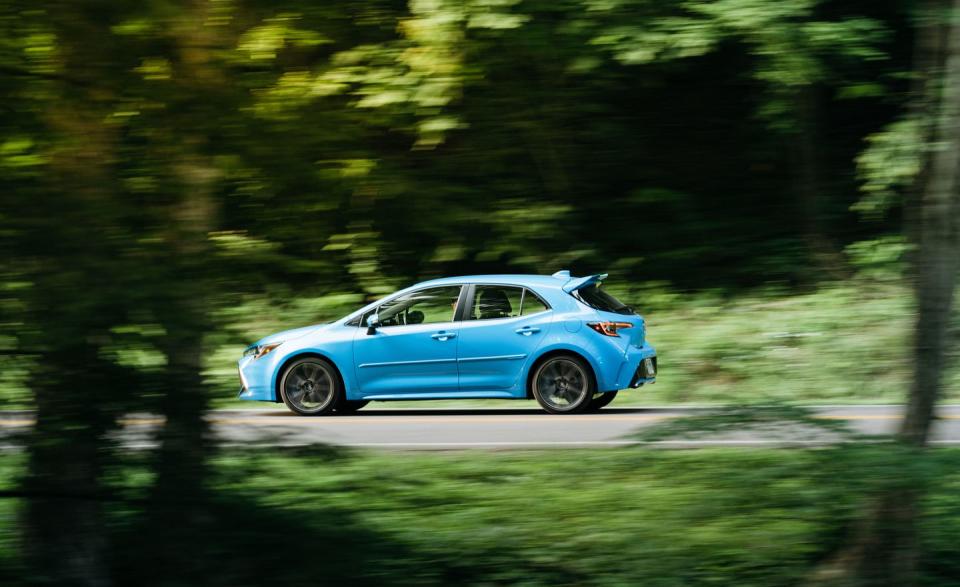
Highs: Affordable, efficient, comfortable on the highway.
Lows: Squishy brakes, polarizing design, lackluster powertrain.
Verdict: You may not hate it, but you won't love it, either.
The Corolla is by far the most interesting of the group to look at, not least because, in its Blue Flame coating, it was the only one not painted a neutral color. But interesting, as anyone familiar with Duchamp's Fountaincan attest to, is not the same as good. The Corolla is all ankles and elbows, and ours wore a wholly unnecessary $375 spoiler atop its rear window. Even with its power bump over last year's engine, the Toyota's 168-hp four-cylinder feels anything but speedy.
The Corolla and this competition's only other naturally aspirated entrant, the Mazda 3, felt sluggish on our hilly driving loop in southern Ohio, requiring more downshifts to maintain speed uphill and more urging to accelerate mid-gear than the three turbocharged cars. The Corolla was smooth on the highway but imprecise once the road turned windy. The brake pedal was a little squishy when we left the office, but after half an hour or so of hard driving, it became alarmingly soft, especially in comparison with the firm pedals in the Civic and the 3. Back at the test track, we recorded a 175-foot stop from 70 mph in the Corolla with no fade, though the tester noted the squishy pedal.
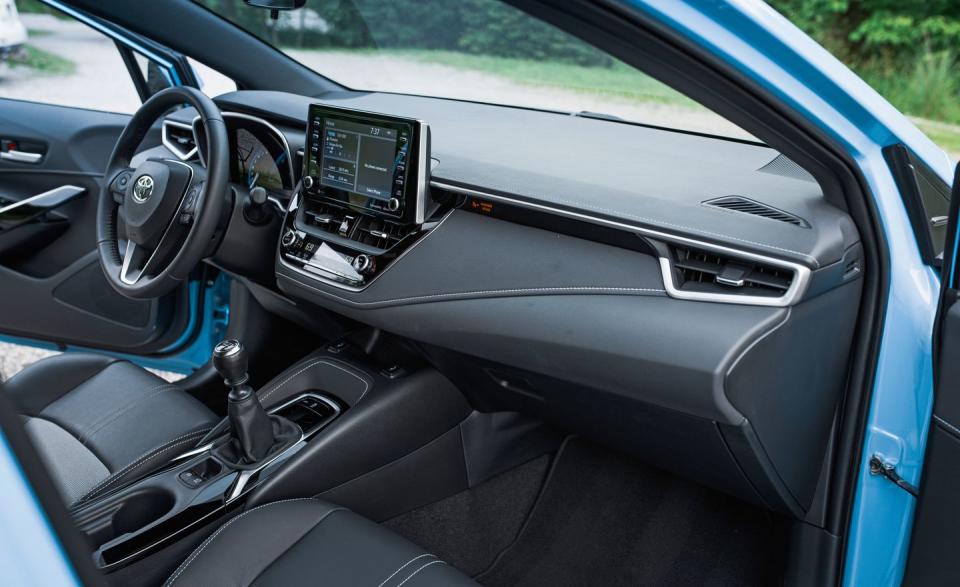
Toyota's hatchback also demands meaningful concessions in comfort and convenience, which make it harder to overlook its dynamic imperfections. The cargo hold has an unusually high floor and offers only 18 cubic feet of cargo space (compared with 25 in the best-in-test Elantra GT). The seating position is likewise uncomfortably high, especially for tall drivers, perhaps an attempt to trick buyers into thinking the Corolla is an SUV. The interior is otherwise agreeable and features heavily bolstered front seats, but neither the level of execution nor the styling can quite match the best in this set.
The Corolla returned 29 mpg after several days of aggressive driving and ran with the pack in testing. The average driver could buy one and live with it happily for many years. It's not a bad car. But it is thoroughly mediocre. Toyota will sell them by the hundreds of thousands anyway.
4th Place:
Volkswagen Golf
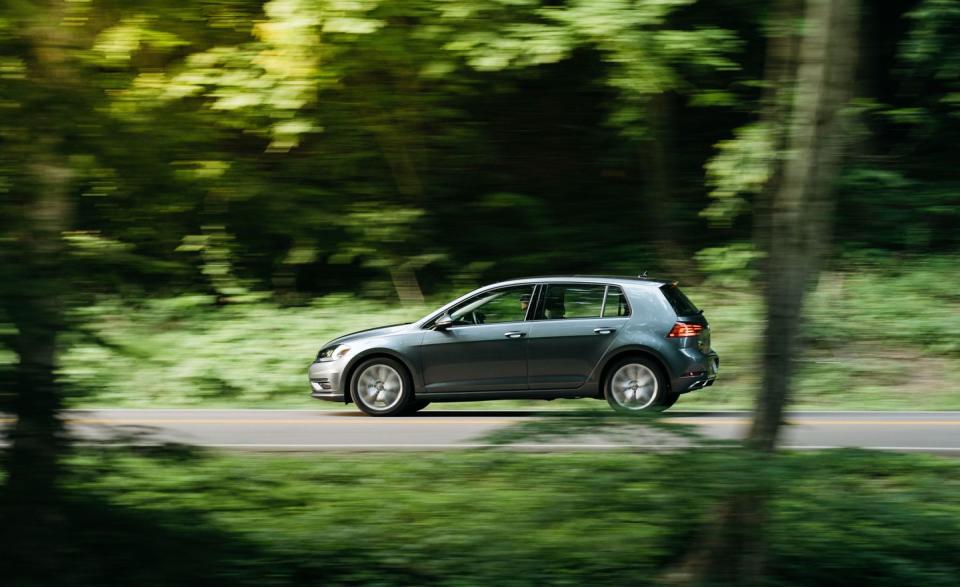
Highs: Accurate handling, comfortable ride.
Lows: Not a GTI, not a Golf R, less powerful than last year's model.
Verdict: We like its brothers better.
The Golf's spot near the bottom of this list is a little surprising, given that it is a perennial fixture on our list of 10Best Cars. But like Kevin Jonas, the Golf needs its family to succeed. Without the company of the Golf R and the GTI®a in particular, Wolfsburg's entry-level hatchback feels a bit underpowered and uninspiring.
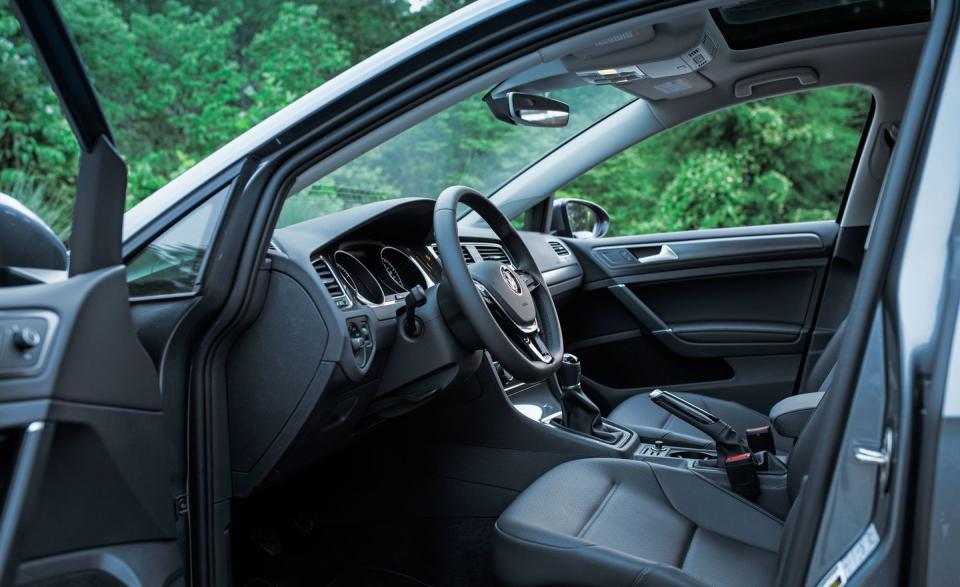
The Golf's design has always been dull, and now that this generation is nearing the end of its life, we're ready for an update. The interior feels sparse, even with the benefit of the 8.0-inch touchscreen infotainment system, and the 147-hp engine isn't quite as peppy as the 170-hp unit it replaced this year. That lack of vim was on full display during our test of top-gear passing times, where the Golf needed 34.6 seconds to accelerate from 30 to 50 mph, nearly four times as long as the Elantra GT needed for the same task and enough to prompt the car's tester to scribble an all-caps "OMG" in the margin of the test sheet. The Golf's shifter also left some of us cold. Senior online editor Mike Sutton called its action "clunky," and art assistant Austin Irwin said it felt "like a plastic spoon in a jar of Legos."
The Golf delivers confidence and competence, with just a little softness in the suspension. It's possible to have a lot of fun in this car, but the entry-level Golf accedes to fun rather than inviting it. It's good, it's practical, it is, as editor-at-large Daniel Pund said, "the Camry of Europe," but it's not the Golf we'd choose. And it seems we're not the only ones. Volkswagen is rumored to be pulling this base model and the SportWagen out of the U.S. market when the eighth-generation Golf makes its debut in 2020. The company promises that the GTI and Golf R will survive the cull, leaving us with more of what we want and less of what we don't really care about.
3rd Place:
Hyundai Elantra GT
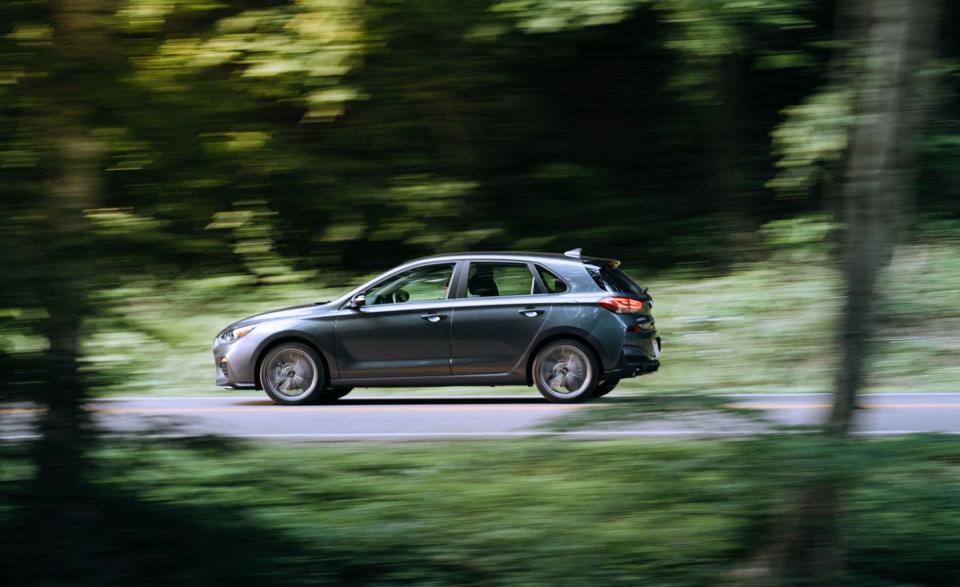
Highs: Peppy engine, upscale features, sticky tires.
Lows: Bouncy ride, numb steering, engine drone.
Verdict: Not quite the whole package.
The Elantra GT N-Line is more overt about its sporting intentions than most in this group. Not only does it carry N badging to link it to Hyundai's performance lineup (which currently consists of only this and the Veloster N but will soon grow to include a Sonata N-Line), but it borrows a steering wheel and sport shifter from the Veloster N. And when it's equipped with a manual transmission, the Elantra GT comes standard with Michelin Pilot Sport 4 tires; the rest of this cohort rides on less aggressive, all-season rubber.
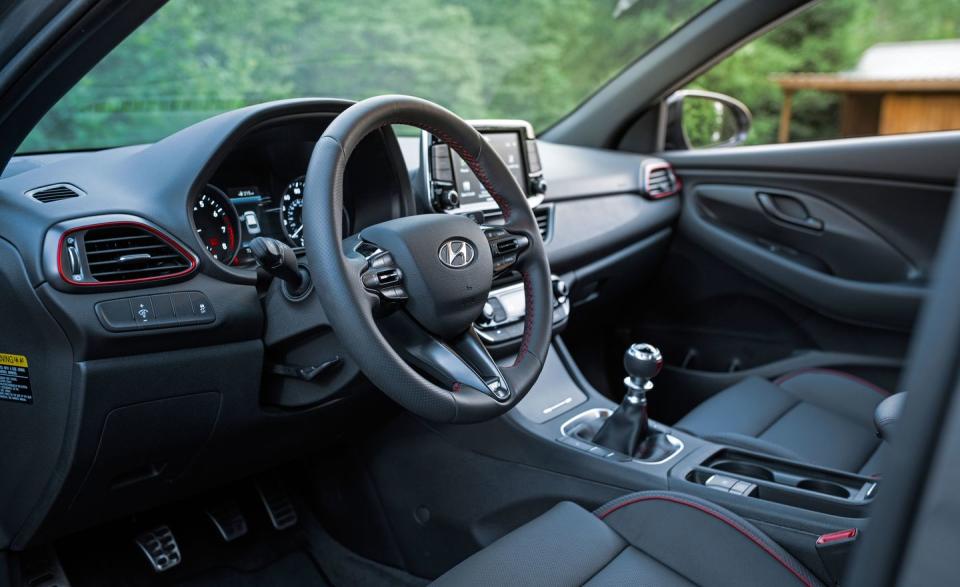
Those tires earned the bulk of the praise for the Elantra's driving prowess, but even as it outgripped and outcornered its competitors, we noticed flaws in the steering (springy), engine (droning), and suspension (bouncy). Sutton called it "spunky without being actually sporty," with the portion of spunk that didn't come from the Pilot Sports attributable to the torquey 201-hp turbocharged 1.6-liter. That engine helped propel the GT from zero to 60 mph in 6.5 seconds, more than half a second quicker than the next-best car in this test. Its quickness was enough to keep us interested, but the Hyundai is missing the alchemy that turns a car made up of good parts into something special.
What the Elantra lacks in magic, it makes up for with the Hyundai values of good ergonomics and surprising feature content. At $24,355 all-in, it's the second-cheapest car here, but you'd never guess it. The exterior design is mature, the interior is comfortable and high scale, and the infotainment system is well organized and offers worlds more functionality than the unit in the Civic. The Elantra is good at many things, but it's only great on paper.
2nd Place:
Mazda 3
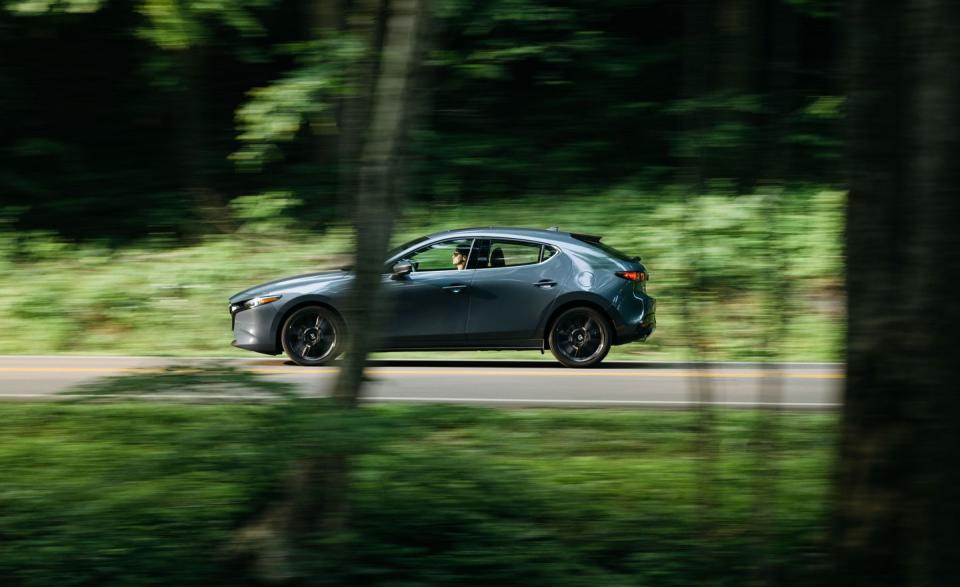
Highs: Luxurious interior, attractive exterior, competent handling.
Lows: Expensive, manual in top trim only, sedate driver.
Verdict: Could be the winner of a different test.
Americans have had to learn some hard lessons about the Electoral College over the last two decades. Now our comparison-test scoring system is affording us the opportunity to teach those lessons to Hyundai and Mazda. Call it a cultural exchange. When the driving was over but before our votes were submitted, we didn't even consider the possibility that the Mazda 3 would be our second-place car. It wasn't anyone's favorite to drive, it's a lot more expensive than the hatchbacks we preferred driving, and we didn't have high expectations for its performance at the test track, which can often swing a car's overall scores significantly.
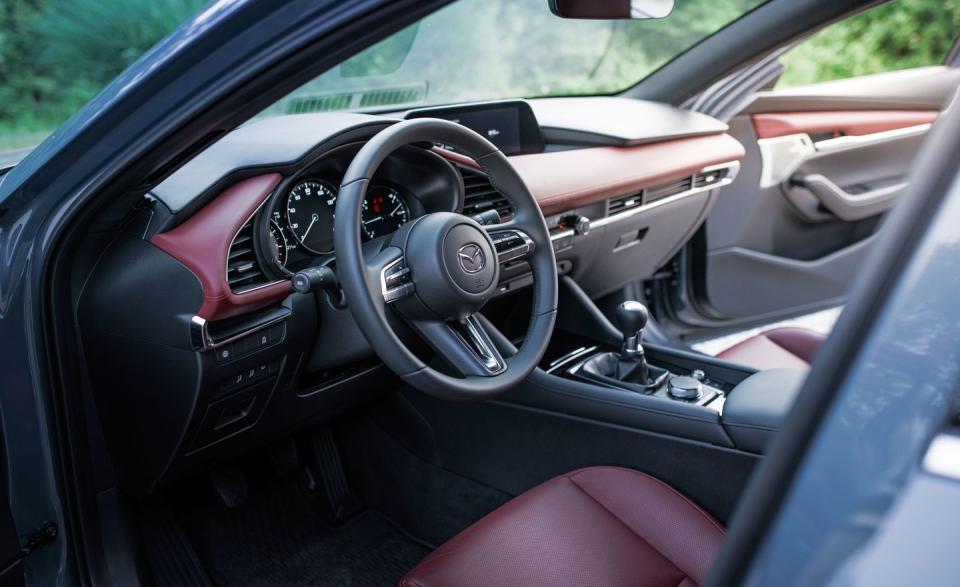
What we hadn't considered is that the Mazda 3 is by far the best-looking, most premium, most comfortable car in this test. It also earned high scores in several powertrain categories, despite a middling performance at the track, largely because the engine is smooth and quiet. With deserved high marks in those categories, our determination that the 3 isn't that fun to drive anymore—a real shame, given Mazda's track record of building sporty cars to sell in otherwise-boring segments—didn't matter that much. And so, a car we had all but counted out came away from this test with a second-place finish, and we came away wondering whether we should have pulled a Zuckerberg and thumbed the scales in favor of our preferred candidates.
We didn't do that, though, because while this Mazda 3 isn't the great driving car it used to be, it remains a standout in this set. It's the one you'd be proud to give your boss a ride in, and it has the most up-to-date exterior design. Outfitted as the 3 was with gray paint and a red leatherette interior, it looks positively sophisticated. It feels that way, too, at least when cruising on the highway, where the Mazda is quieter than its rivals. It doesn't stand up to hard driving quite the same way, though. As vehicle testing director Dave VanderWerp put it, "This is a car that feels worse the harder you drive it."
That's not the way we're used to feeling about Mazdas, but it might be what some drivers want from their manual hatchbacks. In cars this size and at this price point, you simply can't have it all. For drivers who want a small hatchback but value comfort and features over price and performance, the 3 is a valid choice, even if it wouldn't be ours.
1st Place:
Honda Civic Sport
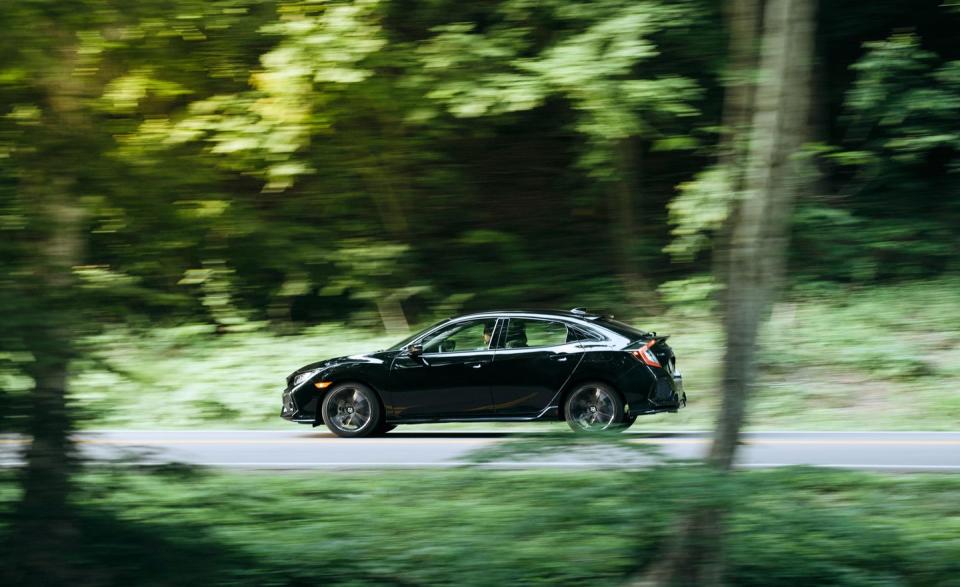
Highs: Eager powertrain, quick handling.
Lows: Noisy at speed, few interior comforts, unfortunate design.
Verdict: Some of the best driving you can get at this price.
The Civic Sport has a lot to live up to. It shares its platform and the basics of its positively atrocious styling with the more powerful, sportier Si and Type R. But unlike the Golf, which fails to live up to the promise of its famous family, the Civic Sport can stand on its own merits. It's not the most powerful car in this set, but its turbocharged four-cylinder is eager off the line, and the six-speed's shifts have short, easy throws.
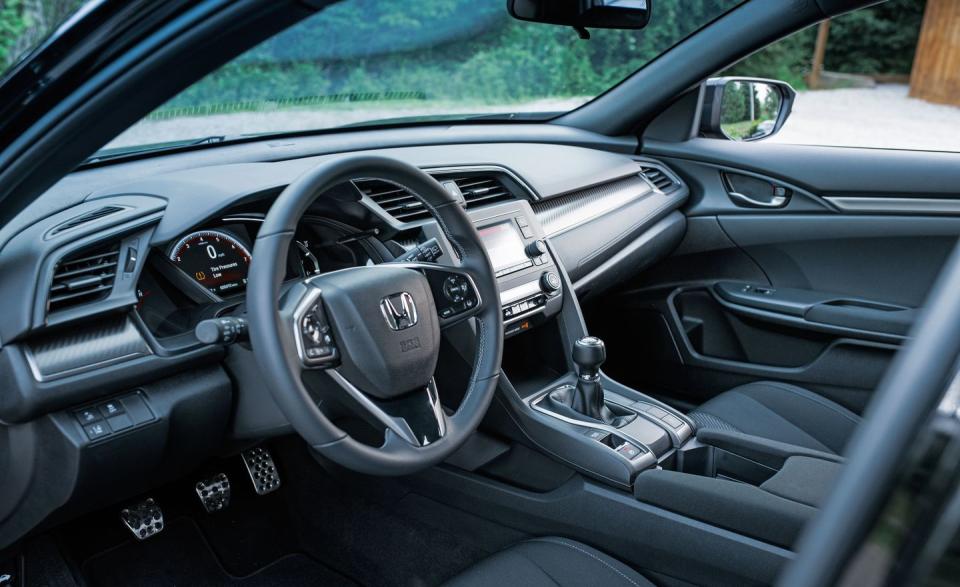
The Civic's chassis is the real star of the show, though. The Sport is stable through corners and feels athletic and nimble on roads where the others in this test begin to show cracks. It doesn't have the benefit of the summer tires that help the Elantra GT feel grippy and settled, but it's more fun to toss around and, at 0.91 g, it nearly matches the Elantra on the skidpad. Honda used its suspension tuning and superresponsive, accurate steering to accomplish a goal that Hyundai seems to have delegated to Michelin.
That said, there are drawbacks to buying a Civic Sport. This car is much more affordable than its perform-ance would suggest, but unlike in the Elantra GT, the interior matches the price. The tiny, pixelated infotainment display might have looked modern a decade ago. The front seats are unsupportive, the center console is molded from hard plastic, and have we mentioned that the exterior design is just plain ugly?

We're willing to look past those faults because alone among the cars tested here, the Sport can provide a purely joyous driving experience. This Civic isn't playing at sportiness; driving enjoyment was baked into every engineering and tuning decision Honda made when building this car. It's a harmonious package in a segment where some competitors have tried to pass off manual transmissions as a shibboleth for sportiness, or use affordable models to urge you into their more expensive offerings. Sure, the Civic Sport is a way for entry-level buyers to get a taste of Honda's racier vehicles. But it's also a fully realized, distilled iteration of its betters, not a weak reflection of them. It's a remarkably uncynical product from a global manufacturer, and it's the hatchback we'd buy.
From the August 2019 issue.
You Might Also Like

 Yahoo Autos
Yahoo Autos 